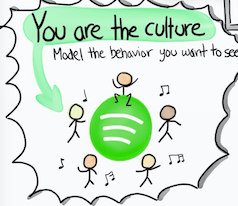You know the saying “don’t shoot the messenger”? Well, that goes both ways – “don’t praise the messenger”. Well, OK, you can shoot or praise the messenger for the quality of the delivery – but not for the message content!
I’ve spent a few years working with Spotify and published a few things that have gained a surprizing amount of attention – especially the scaling agile article and spotify engineering culture video. This has come to be known as the “Spotify Model” in the agile world, although it wasn’t actually intended to be a generic framework or “model” at all. it’s just an example of how one company works. The reason why I shared this material is because my Spotify colleagues encouraged me to, and because, well, that’s what I do – help companies improve, by learning stuff and spreading knowledge.
Since then, many companies have been “copying” the Spotify model, which I found rather scary at first. But now I’ve met quite a number of those companies (and heard back from even more), and so far I have yet to see a case where a company ended up in a worse position than where they were. In fact, some have seen some huge improvements! Pretty surprising actually. So apparently, yes, companies can copy models from each other, and it can sometimes be helpful – mainly because it’s almost always valuable to look at your own organization and process with a critical eye, and take inspiration from others. As long as you adapt to your local context (which most do, eventually).
So, back to the messenger thing.
I’ve noticed, via various blogs and articles and presentations, that people sometimes seem to make the assumption that I invented the Spotify model. Well, I most certainly didn’t! I’m just the messenger. Everything I do at Spotify (and other clients) is collaborative. As coach and mentor I have no formal authority, so I have to work with and through other people. The Spotify model is the result of a lot of people collaborating and experimenting over time, and many aspects of the model were invented without my involvement at all. I certainly wouldn’t want to take credit from the people involved.
So, if you see or hear anyone making the claim that I invented the model, please point out that I didn’t, and refer them to this blog if there are any doubts.
Thanks!
/Henrik





Hi Henrik,
Thanks for sharing all the experiences, lessons and insights that you all had. Indeed, I almost forgot: the team. From now on, not anymore.
But it still takes a good story teller (and cartoon artist 😉 ) to take this to the world. Thanks for that!
Sebastiaan Bekker
Hi Henrik
I’m referring to (what I take is by now a very) famous Spotify youtube video I just came across with: https://www.youtube.com/watch?v=Mpsn3WaI_4k
Do you know whether there are slides, notes or any other written material with the video’s content? I like it a lot and would like to re-use (ie, share) some of the stuff you say there.
Thanks a lot!
Cheers
Mário
Hi Henrik,
Love the content – Could you share what software was used for the animation?
Thanks
Jonathan
I used Intuos 5 (drawing tablet) + Art Rage (drawing program) + Screenflow (recording and editing)
Gartner lists “Spotify” as a “Representative Provider” in their latest “Market Guide for Enterprise Agile Frameworks”, “although it wasn’t actually intended to be a generic framework or “model” at all” … 😉
Yeah, kinda fun how these things happen 🙂